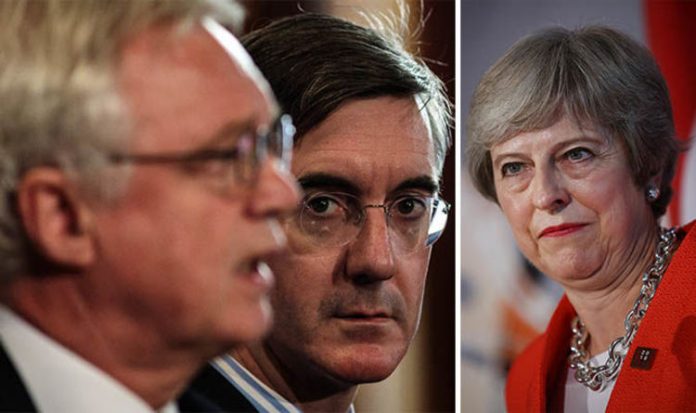[ad_1]
The IEA, a non-profit, free-market think tank, issued the report titled ‘Plan A+: Creating a Prosperous Post-Brexit UK’, claiming it could deliver the “Brexit Prize.”
The plan has already won the backing of leading Brexiteers, including David Davis, Boris Johnson and Jacob Rees-Mogg.
Mr Rees-Mogg dubbed it the “most exciting contribution” to the Brexit debate in months, as the plan sets off a Canada-style free trade deal as an alternative to Theresa May’s contentious Chequers proposal.
But Mr Rees-Mogg said it went even further than the Canada deal struck in 2016, calling it “Canada plus; Super Canada; or Supercalifragilisticexpialidocious Canada.”
What is a Canada-style deal?
Officially known as the EU-Canada Comprehensive Economic and Trade Agreement (CETA), the agreement was signed in October 2016, after seven years of negotiation and ratification.
CETA removes 99 percent of customs duties on European exports to Canada and vice versa.
After seven years, all tariffs on industrial products are due to disappear completely.
A large bulk of tariffs on agricultural products will also be removed.
CETA also allows EU companies the opportunity to bid for public contracts in Canada.
Canada is not obliged under CETA to pay into the EU budget, sign up to such as free movement, or abide by European Court of Justice (ECJ) rulings.
However, the deal has been criticised for its lack of comprehension, as hundreds of exceptions are listed under the trade deal, and CETA does not guarantee Canadian firms any EU financial security.
This means it still poses a challenge for Canada to trade freely in Europe.
What did the IEA proposal say?
As Mr Rees-Mogg indicated, the IEA proposal aims to build on the Canada deal and improve it.
Here are the key points:
-
The UK should stick to the arrangements made on the EU divorce bill, EU citizens rights and the transition period.
-
A new backstop for Northern Ireland should be drawn up.
-
Chequers must go: The IEA plan says a common rulebook for goods but not services, as proposed in Chequers, makes trade deals with non-EU countries “all but impossible.”
-
The plan should involve the elimination of tariffs and quotas on all products the UK does not produce, including foodstuffs that cannot be grown here such as avocados, oranges and rice.
-
The UK should join global trade organisations as soon as possible, including the Cairns Group of agricultural exporters, in particular, to restore sovereignty over British waters in fisheries policy.
-
The report calls for “better” regulation. David Davis, at the launch of the plan, said: “The issue on regulation is ‘who decides?’ Under Chequers it’s the EU, under ‘free trade plus’ it’s us that decides.”
-
One of the most contentious topics throughout negotiations has been Northern Ireland. The IEA plan says Northern Ireland will be treated differently to the rest of the UK, with the UK committing to keeping Northern Ireland compliant with EU laws on animal and plant food health checks.
- However, it adds checks extending beyond animals and food, including for medicines, should be done away from the border with close cooperation between Northern Ireland and the Irish Republic.
-
On immigration, the IEA report says free movement from the EU should be replaced with a worldwide system that “recognises the economic and social benefits and costs of immigration”.
Shanker Singham, the author of the IEA plan, told BBC Radio 4’s Today programme: “Our approach is: well, what is that prize?
“I think that prize is entirely to be found in your independent trade and regulatory policy. It is nowhere else.
“If you don’t have an independent trade and regulatory policy as you leave the EU, then this is only a damage limitation exercise. It can only be a bad result.”
[ad_2]







